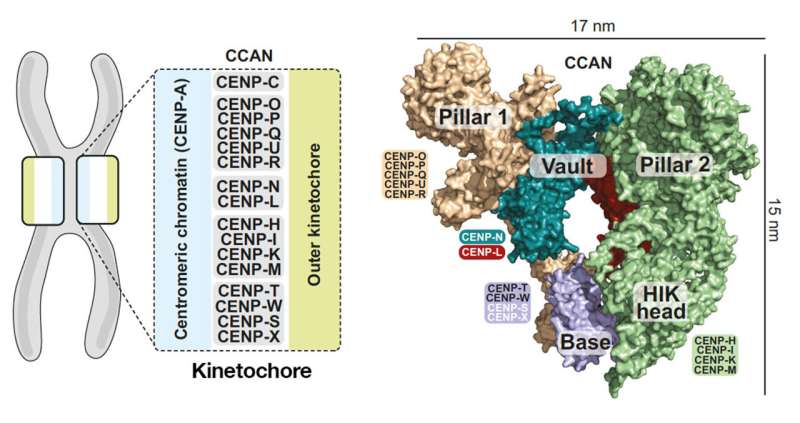
They’ve made some progress with mapping the 3D structure of hundreds of proteins at the core of cell division but unanswered questions remain:
The groups of Andrea Musacchio and Stefan Raunser at the Max Planck Institute of Molecular Physiology in Dortmund are now able to reveal the first detailed structure of a key protein complex for human cell division known as CCAN. By using cryo-electron microscopy, the researchers show important features of the complex’s 16 components and challenge previous assumptions about how the complex is able to recognize the centromere, a crucial region of chromosomes in cell division.
The centromere is a constriction in the chromosome, made of DNA and proteins. Most importantly, the centromere is the dock for the kinetochore, a machinery of about 100 proteins that drives the separation of two identical chromosomes during cell division and their delivery to the daughter cells. Previous research has shown that the kinetochore docks onto the centromere through the CCAN complex: The CCAN interacts with the centromere protein A, the landmark protein of the centromere. CCAN is also responsible for replenishing the centromere protein A once the cell division has taken place. Yet, the details of the interaction between CCAN and the centromere protein A remain elusive…
“Contrary to what was expected, this structure does not directly recognize the centromere protein A in the standard configuration,” says Musacchio.
The centromere protein A is most commonly packed with DNA and other proteins as a nucleosome, the standard unit of the genetic material. The authors are now suggesting that the centromere protein A may be embedded in the centromere with a different configuration that may facilitate the crucial interaction with CCAN. They plan to identify conditions that could lead to this new configuration and prove their hypothesis.
Max Planck Institute of Molecular Physiology, “Structure of key protein for cell division puzzles researchers” at Phys.org (May 13, 2022)
In other words, contrary to expectation, the system is even more complex than supposed. At this point, unguided evolution becomes overwhelmingly implausible because it would take only one misstep to end the process. But people believe what they believe.
The paper is open access.
You may also wish to read: In embryos, we are told, “nothing is left to chance in the ‘seating plan’ for the first few cells.” So: “Nothing is left to chance” even in cell spacing in worm eggs but we are told there is no design behind the universe?